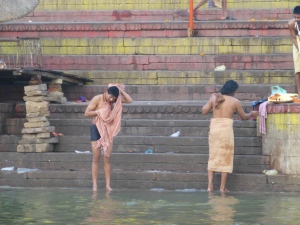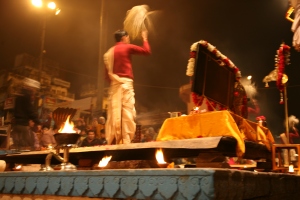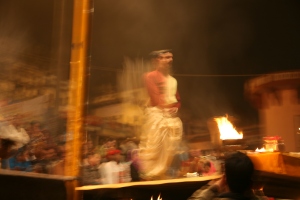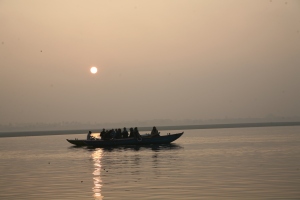 Benares is older than history, older than tradition, older even than legend and it looks twice as old as all of them put together.” Mark Twain 1897.
Benares is older than history, older than tradition, older even than legend and it looks twice as old as all of them put together.” Mark Twain 1897.
Day 1
Shrouded by the dim light of early evening I buck up my courage and walk down a crammed passageway to get to Dasaswamedth, Varanasi’s main ghat. It’s an important place on the Hindu divine cosmic road, and I’m trying to walk with purpose, to look as though I know where I’m going and what’s going on here. ( Although I don’t.)
I’ve lost Ross somewhere in the crowd but I’m determined to press my way alone through throngs of pilgrims, alms seekers, stretcher-bearers carrying covered corpses sadhus (holy men, most fake, some real,) locals and a few other stunned foreign travellers.  The touts are aggressive and close. Too close. I turn my eyes away from them and whatever they shove in my face.
The touts are aggressive and close. Too close. I turn my eyes away from them and whatever they shove in my face.
A putrid stench rakes over me.
 I trip and slide around the garbage, some organic but mostly plastic. Plastic Bags. I do my best to dodge cattle dung, goat turd, dog poop and other unsavouries, including the plastic bags and what may be in them.
I trip and slide around the garbage, some organic but mostly plastic. Plastic Bags. I do my best to dodge cattle dung, goat turd, dog poop and other unsavouries, including the plastic bags and what may be in them.
Will it ever end? Damn. I nearly stepped in it again.
There are too many tacky trinket stalls, too many people, too many piles of wood, too much smoke, too much of everything. I want to get out of here even though I’ve just arrived. So I ask myself. Why are you here, Nancy? What made you come? Where is the light in this City of Light you’ve finally come to visit?
For thousands of years literary masters have written about Varanasi (called Benares or Kashi by locals.) The city has inspired composers and musicians; been painted and photographed by famed artists; explained by philosophers; and spoken about in mysterious tones by my friends who have visited.
Varanasi is the zenith of the Hindu faith and is revered by Jains and Buddhists.
So here I am. But nothing I have seen, read, heard or imagined has prepared me for it.
Then, unexpectedly, the dark passageway opens up. There it is at the bottom of the steps. The River Ganges. It is wide and beautiful and shining in the low western sun.
Along the broad stone steps, called Dasaswamedth Ghat, the Goddess River Ganga spreads out holding thousands of twinkling floating candles, rose petals and flowers. Eerie sounds of horns droning and symbols clanging resonate through the spaces. Smoke and the smell of sandalwood and incense drifts around everything.
I take a deep breath and inhale the moment. The noise, the garbage and even the touts are obliterated.
Ross comes out of the crowd and we stand at the top of the ghat.
“I can’t believe I’m here,” I whisper.
“Amazing. Listen,” says Ross in hushed tones. “The sound is supernatural.”
Our guide, Babalu, leads Ross and I down the steps. We work our way around small groups of musicians sitting crossed-legged around fires, chanting mantras as they play sitars and tablas. The sun will set in a few minutes and the Aarti Puja will begin, an offering to five great elements in the Hindu faith–fire, water, air, earth and the ether that is also known as space.
“For thousands of years this is happening everyday.” Babalu expounds. “We recite the Om loudly and pray for all people, for the well being of all.” And then he lifts his head toward the sky, clasps his palms together and shouts in a loud musical bass voice.
“Ommm ma ma Shiva. Ommm ma ma Shiva. Ommm ma ma Shiva.”
I shiver, memorized by the mystical hold of Mother Goddess Ganga.
Ashish, our oarsman, holds our hands and helps Ross and me into his low-slung wooden boat so we can watch the Puja from the river. The ghats (there are eighty-seven in Varanasi) are busy tonight after days of rain and cold temperatures.
Peacocks, oxen, goats, and dogs stroll along. “Look at those animals.” Ross laughs quietly. “They have attitude. They know they belong, they’re looked after.”
Thousands of people sit on the steps waiting for the Puja to begin; others, women in colourful saris and men in white dhotis, are bathing in the river, believing the Mother Goddess Ganga purifies the soul. I wonder what it would be like to be in the river beside them, but even though I want to hear their stories I hold myself back.  The Ganges is the fifth most polluted river in the world. Environmental efforts to clean it up have been a complete failure. So far.
The Ganges is the fifth most polluted river in the world. Environmental efforts to clean it up have been a complete failure. So far.
Through the smoke and fires I see crumbling palaces in gaudy colours scrunched in between hundreds of temples. “We have 120,000 temples in Benares,” Babalu says, stopping his prayers. “We call it the City of Temples. It’s the spiritual capital of India, founded in 1200 BC. Three thousand years ago. Imagine. Many important people in India own palaces here. It is the city of the great Hindu god, Lord Shiva, the destroyer of evil.” He looks up to the sky. “We come to Benares to be healed, to be purified, to die. To be at peace.”
The jet-black boat we’re in slithers through floating grime and slowly moves down the Ganges. It has lost its glow now and is black like the night sky. The intimate rituals of life are close and very public. Death is especially close. We pause at a burning patch of land surrounded by temples and huge piles of firewood. This is the burning ghat, Manikarnika.
Babalu points to five or six sombre-looking men carrying a bamboo stretcher on their shoulders. “Look there’s a dead body,” he shouts, and Ashish enthusiastically joins in, directing us to look at a corpse shrouded in white. It seems as though they think that’s what tourists like me come here to see. “This is the place Hindus come for liberation from the cycle of life. The cremation ghat are busy 24/7,” Babalu says in a savvy tone.
I turn my head away. The magic of the Ganges loses its hold, the intimacy of life and death is too raw.
“I rather like the matter of fact-ness of it all,” Ross surprises me by saying.
But I have to work hard to try to set aside the ever-present death, poverty and filth in Varanasi and hold onto the beauty of spirituality felt here.
The river is crammed with boats like ours; there is no more room for people to sit (or stand) on the massive ghat. The Aarti Puja ceremony we have come to see seems to me like a big glitzy commercial show.  And maybe it is, although our trusted new friend Babalu tells us it is his duty as a lay Hindu priest in Varanasi to take his turn officiating at the Aarti ceremony four or five times a year. The young priests performing the Aarti tonight are dressed in matching cream coloured dhoti-kurta (skirts and scarves) with flashy deep red shirts and they are swirling giant rings of fire in a cloud of incense and smoke. Some bang cymbals and drums, the volume of their chanting rising to a crescendo. The noise is deafening.
And maybe it is, although our trusted new friend Babalu tells us it is his duty as a lay Hindu priest in Varanasi to take his turn officiating at the Aarti ceremony four or five times a year. The young priests performing the Aarti tonight are dressed in matching cream coloured dhoti-kurta (skirts and scarves) with flashy deep red shirts and they are swirling giant rings of fire in a cloud of incense and smoke. Some bang cymbals and drums, the volume of their chanting rising to a crescendo. The noise is deafening.
Babalu rises above it all and chants Hindu prayers in a loud and fearless voice.
I feel “out of sorts.” In the City of Light I’m in a time machine of some kind, zinging from one century to another. In twenty minutes I’ve come from the bedlam of an ancient world with timeworn rituals to a quiet, pristine place. There is nothing out of place in the one hundred and seventy-five year old Nadesar Palace where we are staying but I’m still reeling from the hullabaloo at the ghat.
“Varanasi is being buried by poverty and filth,” I had choked out when we left the bedlam.
“Change is happening.” Babalu intoned, and then his voice quietened and trailed off. “But it is very slow in Varanasi. People from everywhere come here now. A few years ago we didn’t even have plastic bags. Now we have to deal with more garbage. It’s hard to make change here. The same things have been happening for thousands of years.”
 He hesitated. I’m thinking is he hopeful? “My little grandchildren learn about the environment in school and the youngest one is working on a project to clean up the school yard.” Then he smiled and barked out in that deep strong voice of his, “But when you live here you don’t notice the garbage.”
He hesitated. I’m thinking is he hopeful? “My little grandchildren learn about the environment in school and the youngest one is working on a project to clean up the school yard.” Then he smiled and barked out in that deep strong voice of his, “But when you live here you don’t notice the garbage.”
I find myself thinking about my own home and how I reduce, reuse, and recycle. I’m no saint. My own private Puja is hope for the future.
I scrub, wash my clothes (including my leather walking shoes) and try to calm down with a glass of Sula, Indian white wine.
As the night sky slowly comes to life with stars and planets, the mystical hold of India grabs me again. A curry dinner, prepared especially for us with produce from the palace garden, is delicious and full of fresh herbs, aromatic cumin, turmeric and red pepper.
Illiteracy is the main reason for poverty and the statistics are daunting in this area of India. But they also tell a story of improvements in literacy since we visited twenty years ago. I need to take a closer look at Benares to see what’s been happening.
Day 2 of Lights Temples and Learning is coming soon.
What has been your experience in Benares? Let us know.


Nancy
Why do I need to go there when your blog is so eloquent .
Yes I do need to go there ! .keep well .
Windmill people .
LikeLike
And when you leave Benares, make sure to go to a lovely Yoga place in India to recover…perhaps Neeleshwar in the south. Or back to the the Windmill again. Opposite places make life interesting. Take good care of yourselves.
LikeLike
Thanks for sharing your travel insights. I do not see a date on the posting. When were you there?
LikeLike
Hi Sheila. We really appreciate your interest. We went to Varanasi in January. The evenings were cool and the daytimes very pleasant temperatures. I understand that Varanasi is busy year round, because of its importance in the Hindu faith. It took me a long time to settle down and write this blog (although I had taken copious notes and photos.) To be sure I suffered from culture shock but quieter places (like the World Literacy Project ) and a yoga retreat helped me return to what I know as the real world.
LikeLike